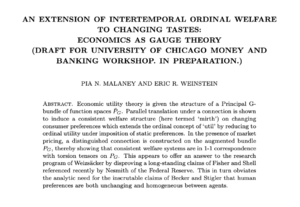An Extension of Intertemporal Ordinal Welfare To Changing Tastes: Economics As Gauge Theory (Content)
Eric Weinstein and Pia Malaney's 2021 draft paper "An Extension of Intertemporal Ordinal Welfare To Changing Tastes: Economics As Gauge Theory", first presented at the University of Chicago Money And Banking Workshop in November 2021, proposes a novel framework for welfare economics by employing concepts from gauge theory and differential geometry to address the challenge of evolving consumer preferences. Traditional economic models often assume static preferences, which limits their ability to handle dynamic welfare analysis. The authors argue that by treating economic utility theory as a gauge theory, one can create a consistent method for comparing welfare even when preferences change over time. They construct a mathematical structure using principal bundles and connections to formalize this approach, enabling the integration of dynamic preferences without abandoning the core principles of neoclassical economics.
The key contribution is the introduction of a "welfare connection" that allows for the decomposition of welfare changes into meaningful components. This approach extends traditional ordinal utility theory by incorporating market data and evolving tastes in a geometric framework. The authors also conjecture that their proposed extension is unique, up to a certain mathematical structure called a torsion tensor. This framework challenges longstanding claims in economics regarding the limitations of welfare analysis under changing preferences, offering a pathway toward more realistic economic modeling that aligns with biological and behavioral considerations.
Summary by Section[edit]
Introduction[edit]
The paper addresses a challenge in welfare economics: the treatment of dynamic, evolving preferences. Traditional economics assumes static preferences, but the authors argue that a gauge theory framework can accommodate changes in ordinal welfare, extending utility theory. This approach counters long-standing claims in economics about the limitations of welfare analysis under changing preferences.
Spaces[edit]
The authors begin by defining various mathematical spaces relevant to the analysis. They introduce a Euclidean vector space representing quantities of goods, and discuss the construction of a space for cardinal utility functions. These functions map baskets of goods to real numbers in a way that satisfies certain mathematical properties, allowing for the representation of evolving consumer preferences.
Gauge Theory as the Natural Economic Calculus for Welfare[edit]
The paper proposes that welfare economics can be reformulated as a gauge theory. In this formulation, ordinal utility maps can be viewed as sections of a principal G-bundle, with the group G representing diffeomorphisms of real numbers. The welfare structure remains consistent when preferences change dynamically.
Cost Function as a Section[edit]
Here, the authors construct mappings related to indifference surfaces and pricing functions. They use these constructions to analyze how market prices and preferences determine unique economic outcomes. By associating cost functions with these surfaces, they develop a framework for connecting consumer preferences with market behavior.
Tangent Spaces[edit]
This section deals with the mathematical properties of the spaces involved in the gauge theory approach. The authors describe how the tangent spaces of the utility function space are related to sections of certain bundles. They introduce the idea of projecting these tangent spaces to analyze infinitesimal changes in welfare.
The Economic Welfare Connection[edit]
The authors define a "welfare connection" as a tool for decomposing changes in utility functions into horizontal and vertical components. This connection facilitates the analysis of changes in welfare by distinguishing between variations due to changing tastes and those arising from external factors like prices.
G-Equivariant Parallel Translation as Non-Perturbative Solution[edit]
The paper presents a solution to the problem of evolving preferences through the concept of parallel translation in gauge theory. This approach allows for consistent welfare comparisons over time by using covariantly constant lifts, providing a non-perturbative method for welfare analysis.
Samuelson Shephard Cost Function as a Section[edit]
The authors explain how market prices can be used to define a natural section of the bundle involved in their gauge-theoretic approach. They demonstrate that the Samuelson-Shephard cost function can be interpreted geometrically, leading to a framework for differentiating welfare changes.
A Conjecture on Uniqueness at the Core of Utility Theory[edit]
The authors propose a conjecture about the uniqueness of the welfare extension they developed. They argue that the theory extends the traditional utility framework to cases with dynamic preferences, suggesting that this extension is unique up to a torsion tensor. This has implications for the construction of welfare maps and cost-of-living indices.
Conclusion[edit]
The paper concludes by challenging existing claims in economic theory, showing that neoclassical economics can indeed accommodate changing ordinal welfare. The authors' framework allows for realistic modeling of dynamic tastes while maintaining consistency with traditional welfare theory, potentially leading to broader applications in economic analysis.
Appendix: The 'Engineering Formula' as Perturbative Solution[edit]
The appendix provides an alternative, perturbative approach to the problem,

